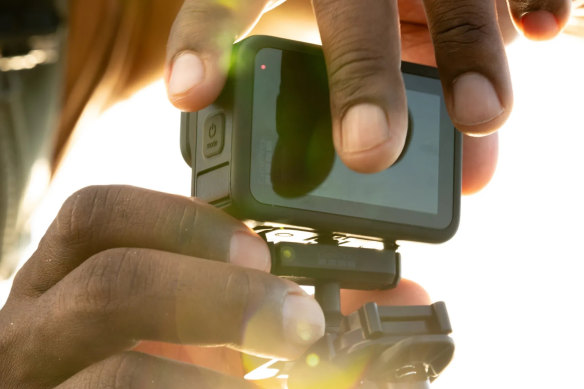
There’s also a Macro Lens Mod with a minimum focus distance of 11 centimetres, which you’ll know is a huge deal if you’ve ever tried to use a GoPro to film anything less than half a metre away. It has a rotating focus ring and focus peaking on the display, meaning the GoPro could become a camera for close-up time-lapses, vlogs or close-up creative process POVs.
For cinematic content there’s also a series of ND filters to manage your light and shutter speed (again, this is handled automatically when you attach one, unless you choose to override it), and coming soon is an Anamorphic Lens mod for cinematic widescreen with no circular distortion.
To be clear, the GoPro is already a $600 camera and these lenses come at an extra cost, so this is not a straight additional functionality. But it does make the camera significantly more versatile.
Magnetic mounting
A core part of the GoPro experience is sticking it to stuff, and that’s always been a little bit fiddly. You can either screw in a professional-style tripod or use the fold-down metal arms to fix it to a mount. But the Hero 13 Black introduces an additional option that’s much easier and (as far as I could tell) just as secure.
Magnets guide the camera onto the new system, where it’s secured by two latches, and you just squeeze them to remove. The idea is that you can install the new system onto any existing GoPro mount, and then move the camera between them. For example, I’ve been using a GoPro mounted on my e-scooter, which without the latch is a hassle because anytime I lock it up somewhere I need to unscrew the mount and take it apart to remove the camera and take it with me. Now the camera just lifts off and the mount stays behind.
I tried my best to rip the GoPro off the latch but it wouldn’t budge. Still, for those who don’t trust the new system (for example, if you’re mounting the camera under a car where you won’t be able to see it), the metal arms are still there.
Super slow-mo
GoPro’s standard 8x slow motion, which is shot at 2.7k, is totally fine and still supported on this new camera. But a new burst slow-mo option opens up so many more possibilities.
For the slowest results, you can tune the resolution down to 720p and shoot 400 frames per second. That means your 15-second shot will turn into more than three minutes of smooth slow-mo, or around a 13x reduction in speed. On the other hand, you can shoot with the full 5.3k resolution, but it will only slow down by 4x and you can only shoot for five seconds (for a 20-second slow-mo clip).
After you’ve shot a clip in slow-mo, the camera takes a few seconds to process, so it is something you’d need to plan out.

Magnetic latches make moving a GoPro between mounts, or keeping it from being stolen, much easier.
What still needs fixing
GoPro claims the new Hero 13 Black has improved battery life and heat dissipation, even with little airflow, as well as faster Wi-Fi, but these are still the camera’s weakest points.
The camera will last two and a half hours on a charge, assuming you’re shooting in 1080p and in ideal conditions. In 4K it’s tough to make it to an hour and a half, and if the sun is on the camera it may shut down long before then.
Loading
GoPro’s Quik app and paid cloud storage subscription are appealing on paper, but I still find it far from a turnkey solution. Ideally, you’ll plug the camera in to charge and it will upload all new footage, optionally erasing it from the camera when it’s done so you can go again. In practice my uploads took hours, and on more than one occasion the camera got way too hot while charging and uploading and shut itself off.
For now, removing the SD card to handle transfers and uploads manually remains the most effective.
Get news and reviews on technology, gadgets and gaming in our Technology newsletter every Friday. Sign up here.









 Add Category
Add Category